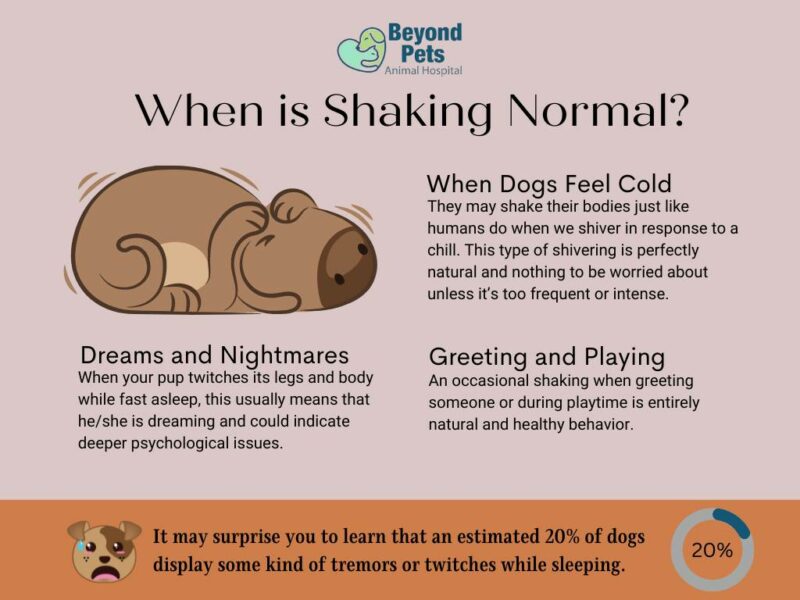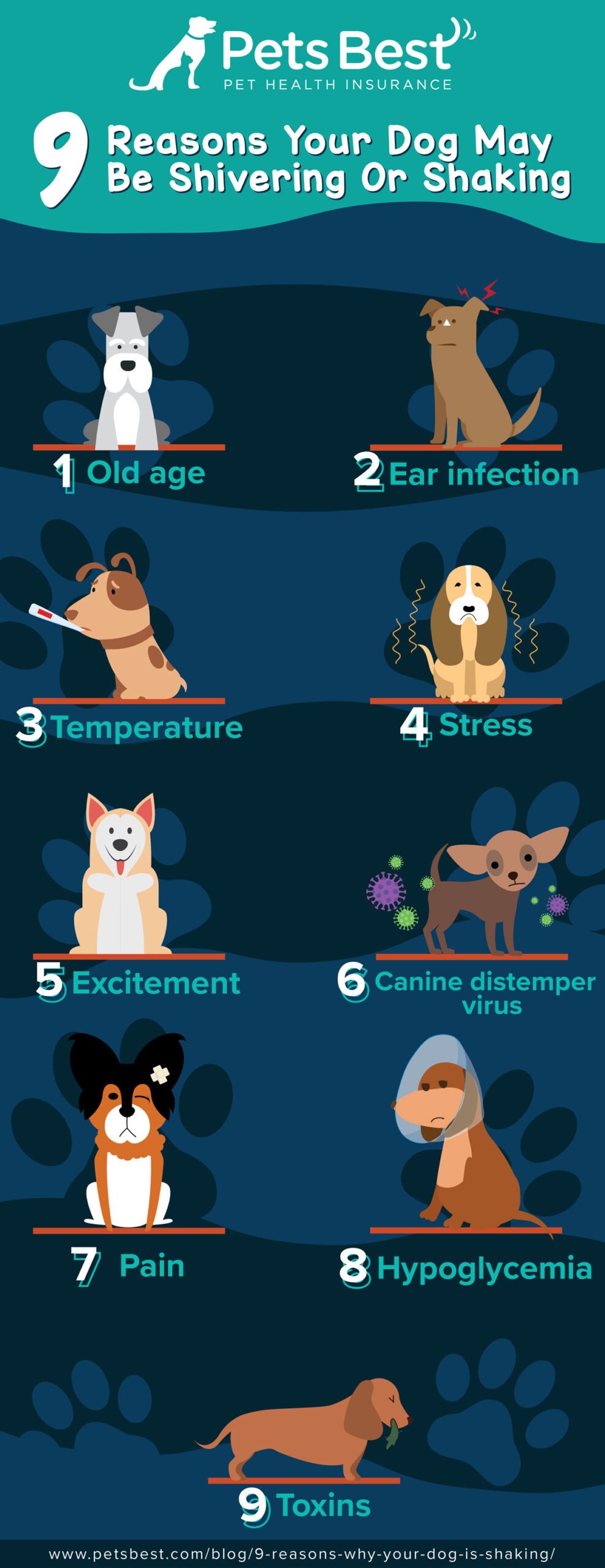Seeing your dog throw up and shake can be alarming. These symptoms often point to an underlying issue. So let’s jump in: Why is My Dog Throwing Up And Shaking?
Many pet owners worry when they notice these signs. Understanding the reasons behind your dog’s vomiting and shaking is crucial. It could be due to something simple, like eating too fast, or something more serious, like an illness. Stress, anxiety, or even dietary changes can also play a role.
By recognizing the possible causes, you can take the right steps to help your furry friend. In this guide, we’ll explore various reasons your dog may be experiencing these distressing symptoms. Knowing what to look for can help you seek the right care for your pet.
Table of Contents

Credit: beyondpets.com
Introduction To Canine Vomiting And Tremors
Many dog owners worry when their pet shows signs of vomiting and shaking. These symptoms can indicate a range of health issues. Understanding them helps you respond quickly. Recognizing the signs is vital. Timely action can make a difference in your dog’s health.
Common Misconceptions
Several misconceptions exist about why dogs vomit and shake. Here are some of the most common:
- Dogs eat grass when sick: Dogs may eat grass for various reasons. It’s not always a sign of illness.
- Vomiting is always serious: Dogs may vomit due to minor issues. Diet changes or stress can cause this.
- Tremors only occur from fear: While fear can cause shaking, other factors exist. Pain, illness, or toxins may also lead to tremors.
Understanding these misconceptions helps in evaluating your dog’s health accurately.
Importance Of Timely Intervention
Quick action is crucial when a dog vomits and shakes. Here’s why:
- Identifying Serious Conditions: Vomiting and shaking can signal serious issues. Conditions like pancreatitis or poisoning require immediate attention.
- Preventing Dehydration: Vomiting can lead to dehydration. This can worsen your dog’s condition quickly.
- Improving Treatment Outcomes: Early detection often leads to better outcomes. Quick veterinary intervention can help your dog recover faster.
Monitor your dog’s behavior closely. Seek veterinary help if symptoms persist. Keeping your dog healthy is a top priority.
Recognizing The Signs
Understanding your dog’s behavior is important. Vomiting and shaking can be signs of health issues. Recognizing these signs helps you take action quickly. Here are key symptoms to watch for.
Symptoms Of Vomiting
Vomiting can show up in different ways. Look for these symptoms:
- Regurgitation: Food comes back up.
- Frequency: Occurs multiple times.
- Color: Yellow bile or undigested food.
- Odor: Foul smell from vomit.
- Loss of Appetite: Dog refuses food.
Observe your dog closely. Note how often they vomit. Keep track of any unusual behavior. This information is helpful for the vet.
Identifying Shaking In Dogs
Shaking can mean different things. It is important to understand the signs:
- Whole Body Tremors: Dog shakes all over.
- Localized Shaking: Only certain body parts shake.
- Panting: Rapid breathing while shaking.
- Restlessness: Cannot settle down.
- Whining or Barking: Vocal signs of distress.
Shaking can indicate pain, anxiety, or illness. Watch your dog closely. Take notes on their behavior. This will help your vet make a diagnosis.
Urgent Causes Behind The Symptoms
When your dog is throwing up and shaking, it can be alarming. These symptoms may signal serious health issues. Understanding the urgent causes is vital for your dog’s health. Quick action can make a difference. Here are some urgent causes to consider:
Toxic Ingestion
Your dog may have eaten something toxic. Common toxins include:
- Chocolate
- Onions and garlic
- Certain plants
- Human medications
Symptoms of toxic ingestion can include:
- Vomiting
- Shaking or tremors
- Excessive drooling
- Seizures
Immediate vet care is necessary. Bring the toxin information to the vet.
Gastrointestinal Obstructions
Obstructions can occur in the stomach or intestines. This can happen if your dog swallows:
- Toys
- Bones
- Clothing
Signs of obstruction include:
- Vomiting
- Lethargy
- Abdominal pain
Obstructions can be life-threatening. Seek veterinary help right away.
Serious Infections
Infections can affect your dog’s health quickly. Common infections include:
- Parvovirus
- Leptospirosis
- Canine distemper
Symptoms of infections may include:
- Vomiting
- Shaking
- Fever
- Diarrhea
Infections require urgent veterinary treatment. Early diagnosis improves recovery chances.

Credit: wagwalking.com
Digestive Issues In Dogs
Dogs can face various digestive problems. These issues can cause discomfort, vomiting, and shaking. Understanding the causes helps in finding solutions. Let’s explore some common digestive issues in dogs.
Food Intolerance
Food intolerance occurs when a dog’s body cannot digest certain foods. Symptoms include:
- Vomiting
- Diarrhea
- Gas or bloating
- Shaking or trembling
Common food intolerances include:
| Food | Symptoms |
|---|---|
| Dairy | Diarrhea, vomiting |
| Wheat | Itchy skin, vomiting |
| Beef | Gas, diarrhea |
| Chicken | Shaking, vomiting |
Identify the food causing issues. Consult a vet for an elimination diet.
Dietary Indiscretions
Dogs often eat things they shouldn’t. This behavior can lead to digestive distress. Common dietary indiscretions include:
- Eating garbage
- Consuming human food
- Ingesting foreign objects
These actions can cause:
- Vomiting
- Shaking
- Abdominal pain
Monitor your dog closely. Prevent access to harmful foods and objects.
Gastroenteritis
Gastroenteritis is inflammation of the stomach and intestines. It often leads to vomiting and shaking. Causes include:
- Infections (bacterial or viral)
- Parasites
- Food allergies
Signs of gastroenteritis:
- Frequent vomiting
- Diarrhea
- Loss of appetite
- Abdominal pain
Seek veterinary help if symptoms persist. Quick treatment can prevent serious issues.
Neurological Concerns
When a dog is throwing up and shaking, it can signal serious issues. Neurological problems often cause these symptoms. Understanding these conditions is crucial for pet owners.
Seizures And Epilepsy
Seizures are sudden, uncontrolled electrical disturbances in the brain. They can cause shaking, twitching, and loss of consciousness. Epilepsy is a common cause of seizures in dogs.
- Signs of seizures include:
- Shaking or twitching.
- Staring blankly.
- Loss of control.
- Paddling of legs.
Seizures can lead to vomiting. This may happen during or after a seizure. If your dog has seizures, visit a veterinarian. They may suggest:
- Blood tests.
- Neurological exams.
- Medications to control seizures.
Vestibular Disease
Vestibular disease affects balance and coordination. It can make dogs feel dizzy and disoriented. Symptoms include:
- Shaking or trembling.
- Nausea and vomiting.
- Tilting of the head.
- Unsteady walking.
This condition can be sudden and alarming. Many dogs recover with proper care. A veterinarian can diagnose vestibular disease through:
| Diagnosis Method | Description |
|---|---|
| Physical Exam | Check for balance and coordination issues. |
| Blood Tests | Rule out infections or toxins. |
| X-rays or MRI | Look for tumors or structural issues. |
Early detection is vital. Quick veterinary attention can lead to better outcomes. Monitor your dog closely. Note any unusual behavior or symptoms.
Immediate Care Strategies
When a dog is throwing up and shaking, it can be alarming. Quick action is necessary. Knowing how to care for your dog can make a difference. Here are some immediate care strategies to follow.
First Aid At Home
Start with these first aid steps:
- Assess the situation: Check for other symptoms like diarrhea, lethargy, or bloating.
- Monitor your dog: Keep an eye on their behavior. Note any changes.
- Withhold food: Avoid feeding your dog for 12 hours. This gives their stomach a rest.
- Provide water: Ensure fresh water is available. Offer small sips to prevent dehydration.
- Keep them calm: Create a quiet space. Reduce stress and anxiety for your dog.
These steps help stabilize your dog. If symptoms persist, take further action.
When To Rush To The Vet
Some situations require immediate veterinary care. Watch for these warning signs:
| Symptom | Action |
|---|---|
| Persistent vomiting | Visit the vet immediately. |
| Severe shaking or tremors | Get professional help right away. |
| Blood in vomit | Rush to the vet. |
| Signs of pain or discomfort | Consult your veterinarian. |
| Vomiting after eating something unusual | Contact the vet for advice. |
Act quickly. Prompt attention can save your dog’s life.
Diagnostic Approach
Understanding why your dog is throwing up and shaking is crucial. A proper diagnostic approach helps determine the cause. This process often involves clinical examinations, laboratory tests, and imaging techniques. Each step provides valuable insights into your dog’s health.
Clinical Examinations
A clinical examination is the first step in diagnosing your dog’s condition. A veterinarian will check various aspects of your dog’s health, such as:
- General appearance
- Body temperature
- Heart rate
- Respiratory rate
- Abdominal palpation
During this examination, the vet may look for signs of dehydration, pain, or swelling. These signs can indicate serious issues. Always note any additional symptoms your dog displays. This information aids the veterinarian significantly.
Laboratory Tests
Laboratory tests provide deeper insights into your dog’s health. Common tests include:
- Blood tests: Check for infections, organ function, or anemia.
- Urinalysis: Assesses kidney function and hydration.
- Fecal tests: Look for parasites or gastrointestinal issues.
These tests help pinpoint the cause of vomiting and shaking. Quick results can lead to faster treatment.
Imaging Techniques
Imaging techniques help visualize internal structures. Common methods include:
| Technique | Description |
|---|---|
| X-rays | Shows bones and some organs. |
| Ultrasound | Provides images of soft tissues and organs. |
| CT scans | Gives detailed cross-sectional images. |
These imaging techniques help identify blockages or abnormalities. They provide a clear view of your dog’s internal health.
Long-term Management
Managing your dog’s health is crucial. If your dog is throwing up and shaking, long-term solutions are needed. This section discusses dietary adjustments, medications, treatments, and how to monitor your dog effectively.
Dietary Adjustments
Changing your dog’s diet can help reduce vomiting and shaking. Here are some important tips:
- High-Quality Food: Choose dog food with quality ingredients.
- Frequent Small Meals: Feed smaller amounts more often.
- Avoid Table Scraps: Human food can upset their stomach.
- Hydration: Ensure your dog has access to fresh water.
Consult your vet for specific dietary recommendations. Sometimes, a special diet may be necessary.
Medications And Treatments
Medications can help manage symptoms. Your vet may suggest:
- Antiemetics: These reduce vomiting.
- Antacids: These help with stomach acid.
- Probiotics: These support gut health.
Follow your vet’s instructions carefully. Regular check-ups are important to monitor progress.
Monitoring And Prevention
Keep a close eye on your dog’s behavior. Look for signs of distress or changes in eating habits. Here are some tips:
- Keep a log of vomiting episodes.
- Note any changes in appetite or energy.
- Observe their environment for stressors.
Preventive measures can also help:
- Regular vet visits.
- Vaccinations on time.
- Keep harmful items out of reach.
Taking proactive steps can lead to a healthier and happier dog.
Preventative Measures
Keeping your dog healthy is key. Preventing issues like vomiting and shaking helps maintain their well-being. Here are some effective measures to consider.
Safe Environment
Creating a safe space for your dog is essential. Avoid hazards that can harm them. Here are some tips:
- Keep harmful substances out of reach.
- Secure trash cans to prevent scavenging.
- Store medications safely.
- Watch for small items they might swallow.
- Limit access to toxic plants.
A safe environment reduces the risk of accidents. Regularly check your home for potential dangers. Ensure your dog has a calm space to rest.
Regular Health Check-ups
Routine vet visits are important. Regular health check-ups help catch problems early. They also ensure vaccinations are up to date. Here’s what to consider:
| Check-Up Frequency | Age Group |
|---|---|
| Every 6 months | Puppies and Seniors |
| Once a year | Adults |
During check-ups, discuss any changes in behavior. Report symptoms like vomiting or shaking. Your vet can provide guidance tailored to your dog’s needs.
Stay informed about your dog’s health. Regular visits foster a strong bond with your vet. This can lead to better care for your furry friend.
:strip_icc()/shaking-in-dogs-4177790_FINAL-resized-ec131de3ebac484c89f552451feab57e.png)
Credit: www.thesprucepets.com
Frequently Asked Questions
Why Is My Dog Throwing Up And Shaking?
Vomiting and shaking in dogs can indicate various issues. Common causes include gastrointestinal problems, stress, or poisoning. It’s essential to monitor your dog’s behavior and consult a veterinarian for proper diagnosis and treatment.
What Should I Do If My Dog Is Shaking?
If your dog is shaking, first assess their environment. Check for potential stressors or hazards. Provide comfort and warmth. If shaking persists or is accompanied by vomiting, seek veterinary advice immediately to rule out serious conditions.
Can Anxiety Cause My Dog To Vomit?
Yes, anxiety can lead to vomiting in dogs. Stressful situations, such as loud noises or changes in routine, can upset your dog’s stomach. It’s crucial to identify and alleviate the anxiety triggers to help prevent future vomiting episodes.
When Should I Take My Dog To The Vet?
If your dog is vomiting and shaking persistently, visit the vet. Immediate care is necessary if symptoms last more than a few hours. Additionally, seek help if you notice blood in the vomit or other concerning symptoms.
Conclusion
Seeing your dog throw up and shake can be scary. It’s important to pay attention to these signs. They might mean your dog is feeling unwell. Always check for other symptoms. Contact your vet if things don’t improve. Quick action can help your furry friend recover.
Keeping your dog healthy is a priority. Regular check-ups and a good diet are essential. Stay informed about your dog’s health. A little knowledge goes a long way. Your dog depends on you for care and support. Take action for their well-being today.



